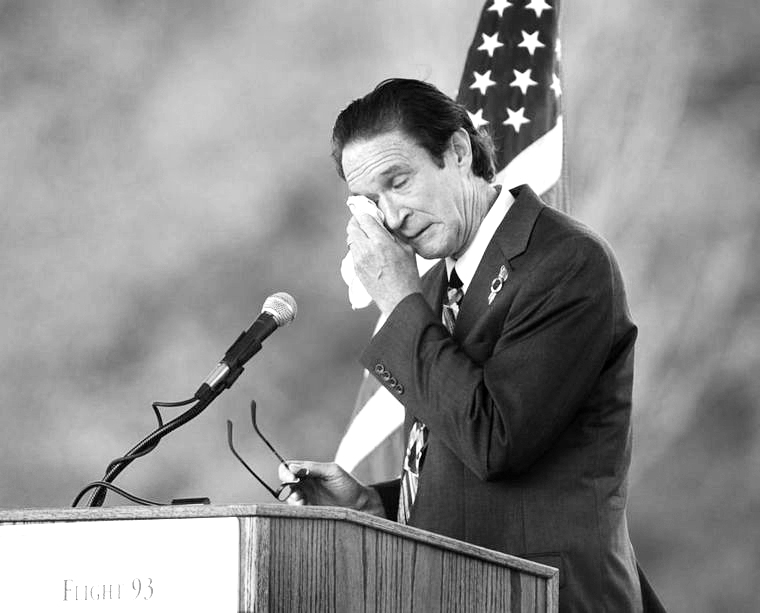9/11 Questions
“No bodies were found in Shanksville”, said coroner Miller
Miller is the coroner of Somerset County, Pennsylvania. He was among the first people to arrive at the alleged Flight 93 crash site on the morning of 9/11.

Wallace Miller is the coroner of Somerset County, Pennsylvania. He was among the first people to arrive at the alleged Flight 93 crash site on the morning of 9/11.
“I stopped being coroner after about 20 minutes, because there were no bodies there. It became like a giant funeral service.”
He later recounted to the Washington Post what he’d seen when he first got there: “I stopped being coroner after about 20 minutes, because there were no bodies there. It became like a giant funeral service.” (Peter Perl, “Hallowed Ground,” Washington Post, 5/12/2002) Since there were 44 people on board Flight 93, a crash site with “no bodies” makes no sense. Where were the victims? Something appears to have been seriously wrong. Yet Miller now seems to dispute his earlier claim. In the recent BBC documentary 9/11: The Conspiracy Files, he explained: “I said that I stopped being a coroner after about 20 minutes because it was perfectly clear what the cause and manner of death was gonna be.
“This is the most eerie thing. I have not, to this day, seen a single drop of blood. Not a drop.”
It was a plane crash but yet it was a homicide because the terrorists hijacked the plane and killed the people, and the terrorists committed suicide. So from that point, yes it was a misquote, because the point that I was trying to make was, after that it more or less became a large funeral service.
“The BBC documentary’s producer Guy Smith endorsed this claim, telling Loose Change creator Dylan Avery that Miller meant his earlier statement only as “a simile. … It looked as if that had happened. … But he didn’t mean that literally.” (9/11: The Conspiracy Files, BBC 2, 2/18/2007)
Was the Washington Post mistaken? Did they “misquote” Wallace Miller? Other reports suggest differently. In the 12 months following 9/11, Miller in fact described the surprising lack of human remains at the Flight 93 crash site, repeatedly and unequivocally: He told author David McCall: “I got to the actual crash site and could not believe what I saw. … Usually you see much debris, wreckage, and much noise and commotion. This crash was different. There was no wreckage, no bodies, and no noise. … It appeared as though there were no passengers or crew on this plane.” (David McCall, From Tragedy to Triumph, 2002, pp. 86-87)
He told the Pittsburgh Post-Gazette: “It was as if the plane had stopped and let the passengers off before it crashed.” (Tom Gibb, “Newsmaker: Coroner’s quiet unflappability helps him take charge of Somerset tragedy,” Pittsburgh Post-Gazette, 10/15/2001)
He told CNN: “It was a really a very unusual site. You almost would’ve thought the passengers had been dropped off somewhere. … Even by the standard model of an airplane crash, there was very little, even by those standards.” (CNN, 3/11/2002)
Author Jere Longman wrote: “Wallace Miller, the Somerset County coroner, arrived and walked around the [crash] site with [assistant volunteer fire chief Rick] King. … They walked around for an hour and found almost no human remains. ‘If you didn’t know, you would have thought no one was on the plane,” Miller said. “You would have thought they dropped them off somewhere.”” (Jere Longman, Among the Heroes, 2002, p. 217)
Recalling the crash scene, Miller told the Pittsburgh Tribune-Review: “This is the most eerie thing. I have not, to this day, seen a single drop of blood. Not a drop.” (Robb Frederick, “The day that changed America,” Pittsburgh Tribune-Review, 9/11/2002)
Australian newspaper The Age reported: “Miller was familiar with scenes of sudden and violent death, although none quite like this. Walking in his gumboots, the only recognisable body part he saw was a piece of spinal cord, with five vertebrae attached. ‘I’ve seen a lot of highway fatalities where there’s fragmentation,’ Miller said. ‘The interesting thing about this particular case is that I haven’t, to this day, 11 months later, seen any single drop of blood. Not a drop. The only thing I can deduce is that the crash was over in half a second. There was a fireball 15-20 metres high, so all of that material just got vaporised.'” (“On Hallowed Ground,” The Age, 9/9/2002)
It would be ridiculous to claim that these accounts were all ‘misquotes.’ Furthermore, several other witnesses also made the same observation, and later said they saw virtually no human remains at the Flight 93 crash site: According to the Pittsburgh Tribune-Review, when former firefighter Dave Fox arrived at the scene, “He saw a wiring harness, and a piston. None of the other pieces was bigger than a TV remote. He saw three chunks of torn human tissue. He swallowed hard. ‘You knew there were people there, but you couldn’t see them,’ he says.” (Robb Frederick, “The day that changed America,” Pittsburgh Tribune-Review, 9/11/2002)
“Where is the plane?”
Local FBI agent Wells Morrison told author Glenn Kashurba what he saw when he arrived at the crash site: “We arrived in the immediate area and walked up to the crater and the burning woods. My first thought was, ‘Where is the plane?’ Because most of what I saw was this honeycomb looking stuff, which I believe is insulation or something like that. I was not seeing anything that was distinguishable either as human remains or aircraft debris.” (Glenn Kashurba, Courage After the Crash, 2002, p. 110)
After hearing a plane was down nearby, Jeff Phillips, who worked at Stoystown Auto Wreckers, “left work to locate the crash site,” along with a colleague. “But when we arrived,” he says, “Almost nothing was recognizable. The only thing we saw that was even remotely human was half a shoe that was probably ten feet from the impact area.” (David McCall, From Tragedy to Triumph, 2002, pp. 29-30)
Jon Meyer, a reporter with WJAC-TV, says: “We were so early that they hadn’t had a chance to set up a barrier for the press. … I was able to get right up to the edge of the crater. … All I saw was a crater filled with small, charred plane parts. … There were no suitcases, no recognizable plane parts, no body parts.”(Newseum, Running Toward Danger, 2002, p. 148)
Faye Hahn, an EMT, responded to the first reports of the crash. She says: “Several trees were burned badly and there were papers everywhere. We searched. … I was told that there were 224 passengers, but later found out that there were actually forty. I was stunned. There was nothing there.” (David McCall, From Tragedy to Triumph, 2002, pp. 31-32)
Despite this absence of human remains at the Flight 93 crash scene, the Washington Post reported: “The 33 passengers, seven crew and four hijackers together weighed roughly 7,000 pounds. … Hundreds of searchers who climbed the hemlocks and combed the woods for weeks [after 9/11] were able to find about 1,500 mostly scorched samples of human tissue totaling less than 600 pounds, or about 8 percent of the total.” (Peter Perl, “Hallowed Ground,” Washington Post, 5/12/2002)
By December 19, 2001, “the remains of the 40 passengers and crew, and, by process of elimination, the four hijackers” had all been identified. (Steve Levin, “Flight 93 victims’ effects to go back to families,” Pittsburgh Post-Gazette, 12/30/2001)
Ref: http://shoestring911.blogspot.com/2013/02/shanksville-pennsylvania-on-911.html

Leave a Reply

 Crime5 years ago
Crime5 years agoLawsuit Filed Against WHO, CDC & the Davos Group for Crimes Against Humanity

 Crime5 years ago
Crime5 years agoPolice Drags Man Out of Home After Neighbor Snitches on Residents For “Illegally Gathering”

 Government4 years ago
Government4 years agoThe CDC Caught Changing the Definition of ‘Vaccine’ and ‘Vaccination’

 International5 years ago
International5 years agoAirlines Warning COVID-19 VACCINATED NOT TO FLY!





















P Dunbar
28/09/2022 at 10:27 AM
Look up Northwest Airlines Electra crash Tell City, Indiana in the late 1950’s. Similar. Digging down, they encountered a large mass of human flesh. Huge health hazard. They filled in the hole and placed a monument.